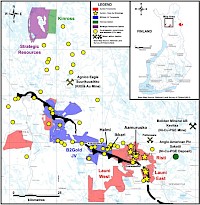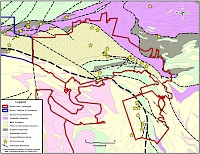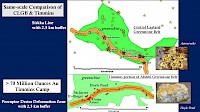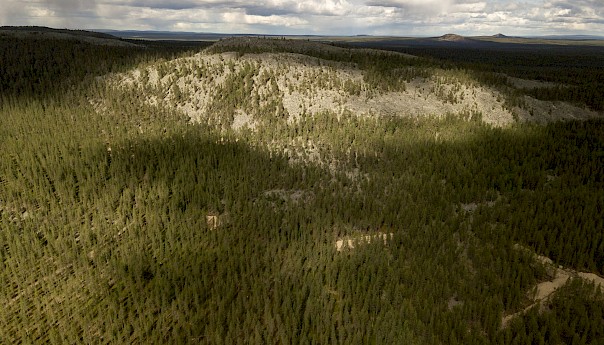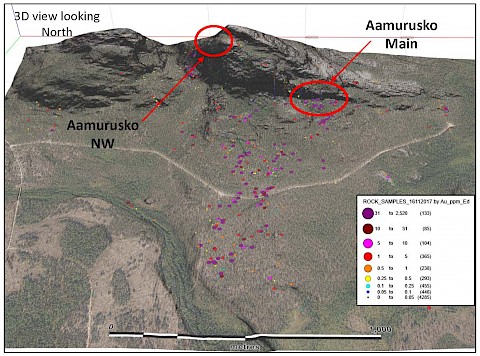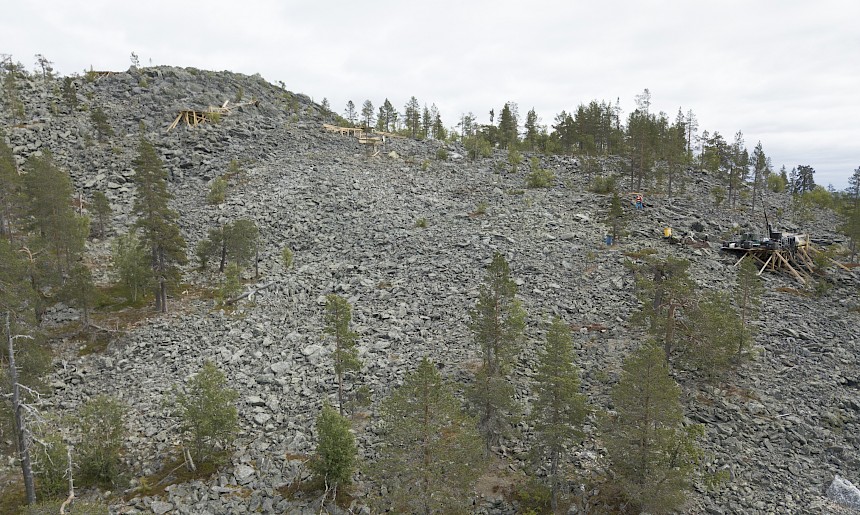Risti
Maps
Latest News
- Feb 27, 2024 - Aurion Intersects 3.68 g/t Au over 11.35 m at the Kaaresselkä Area on the Wholly Owned Risti Property
- Sep 12, 2023 - Aurion Identifies New Gold Zones at the Kaaresselkä Prospect, on the Wholly Owned Risti Property
- Feb 21, 2023 - Aurion Extends Mineralization to 2.41 g/t Au over 56.55 m at Kaaresselkä in Emerging Gold System, Critical Minerals Identified
Overview
The Risti Project covers approximately 16 197 ha in the Central Lapland Greenstone Belt (“CLGB”) in northern Finland. Aurion acquired the first exploration licence in 2014. The Risti Project is located 10 km NNW of Sodankylä, Finland, which is a 40-minute drive along paved and all-weather gravel roads through rolling hills and forests.
The geological setting of the Risti Project has many similarities to prolific gold-rich orogenic gold belts globally, specifically the Timmins camp of the Abitibi region of Northern Ontario, Canada. The Aamurusko zone appears to be underlain by young unconformable clastic rocks (sandstones and conglomerates) of the Kumpu group. These Kumpu group conglomerates resemble the Timiskaming conglomerates of the Timmins and Kirkland Lake area of the Abitibi and occur in a similar geo-tectonic setting (both represent the youngest stratigraphic sequence within their respective belts). The Kumpu group and the Timiskaming group were deposited in late orogenic extensional basins. They form in relation to major movement along regional faults or deformation zones. In the Abitibi province, many high-grade, multi-million-ounce gold deposits are temporally and spatially associated with the Timiskaming conglomerates (or their equivalents) in close proximity to major regional deformation (fault) zones such as the Porcupine-Destor or Cadillac Lake-Larder Lake deformation zones. The Kumpu group appears to have been deposited in a similar geological setting adjacent to the Sirkka shear zone, which is a major deformation zone in the CLGB. Strong alteration including fuchsite, tourmaline, iron carbonate and albite associated with quartz veining and gold mineralization is seen along the entire length (> 100 km) of this structure.
Aurion has been exploring its wholly-owned, flagship Risti Project since 2015, and has made multiple gold discoveries since. Significant new gold discoveries at Risti include: Aamurusko Main, Aamurusko NW (NoNiin), Notches, YNOT, A2 and Risti NW. The property also hosts the Kaaresselkä prospect discovered in the 1980’s by the Geological Survey of Finland. Aurion’s pipeline of gold prospects at Risti are each at a different stage in the exploration process. Most gold prospects at Risti are accessible by 4-wheel drive.
Drill results presented herein are core lengths and may not represent true width. Channel sample results are surface channel cuts that also may not represent true width. Gold assay values are uncut. Prospecting grab samples may be selective, and not representative of overall grade.
Aamurusko
Aamurusko quickly became the focus of exploration after Aurion prospectors discovered 133 high grade gold bearing boulders in late 2016 with an average grade of 74 g/t Au. Since then more than 1 200 gold bearing quartz boulders with an average grade of 25 g/t Au have been sampled over an area of 1.3 km by 1.7 km. Aurion has identified two sources of the boulders via drilling and believes there are more sources.
3D image of Aamurusko gold boulder debris field and current discoveries
Aamurusko Main consists of gold-bearing quartz veins occurring near the sheared contact between sedimentary rocks and a gabbro intrusion, located on the south side of a steep, prominent ridge glacially up-ice from high-grade boulders.
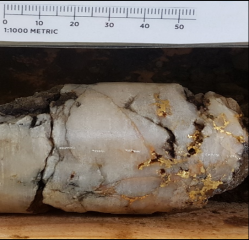
High Grade Core (AM18042)
Drilling Highlights from Aamurusko Main:
- 789.06 g/t Au over 2.90 m (including 3510.00 g/t Au over 0.65 m) from 116.10 m (Drill hole AM18042)
- 42.28 g/t Au over 4.00 m from 40.00 m (Drill hole AM19082)
- 24.50 g/t Au over 4.75 m from 48.80 m (Drill hole AM19081)
- 22.63 g/t Au over 3.53 m (including 52.30 g/t Au over 1.4 m) from 44.47 m (Drill hole AM19114)
- 18.47 g/t Au over 2.76 m (including 93.70 g/t Au over 0.51 m) from 43.94 m (Drill hole AM19113)
Drilling 235 m east of Aamurusko Main also returned significant drill intercepts:
- 9.62 g/t Au over 1.74 m from 26.30 m (Drill hole AM18035)
- 8.74 g/t Au over 1.55 m from 36.65 m (Drill hole AM18035)
- 12.45 g/t Au over 5.20 m (including 66.70 g/t Au over 0.50 m and 54.30 g/t Au over 0.49) from 53.50 m (Drill hole AM18035)
Aamurusko Northwest (NW) is approximately 600 m northwest of Aamurusko Main target. This target consists of a 10-30 m wide zone of gold-bearing quartz veins within altered and mineralized clastic sedimentary rocks. Drilling has delineated Aamurusko NW to 150 m vertical depth and the target is open to extension.
Drilling Highlights from Aamurusko NW:
- 13.31 g/t Au over 19.54 m (including 22.58 g/t Au over 8.18 m) from 77.64 m (Drill hole AM19095)
- 3.51 g/t Au over 31.12 m from 55.88 m (Drill hole AM19094)
- 6.84 g/t Au over 19.00 m (including 16.36 g/t Au over 7.3 m) from 83.80 m (Drill hole AM19109)
- 23.41 g/t Au over 11.10 m (including 51.95 g/t over 4.15 m) from 133.00 m (Drill hole AM19106)
- 16.17 g/t Au over 4.00 m (including 109.00 g/t Au over 0.58 m) from 97.10 m (Drill hole AM19105)
Note: All widths are core widths, true width is not known at this time, all assay values are uncut.
Core drilling at Aamurusko has intersected gold mineralization to a depth of 180 m below surface with numerous drill core intercepts exceeding 15 g/t Au. Gold mineralization at Aamurusko Main and Aamurusko NW is hosted within multiple rock types including clastic sedimentary rocks, gabbro and mafic volcanics. Mineralization remains open to further exploration both laterally and to depth.
Quartz veins encountered by drilling are variably mineralized with trace to a few percent iron oxides (after sulphides), pyrite, arsenopyrite, pyrrhotite, chalcopyrite, galena, sphalerite and/or locally visible gold (“VG”). The host rock also contains fuchsite, sericite, potassium feldspar and iron carbonate alteration of variable intensity.
Notches
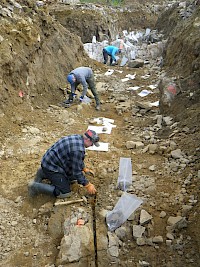 Notches is a 1 km by 5 km long outcrop ridge notched with four lineaments identified from LIDAR imagery. Prospecting this ridge lead to multiple gold showings in quartz sub-crop. Over 1 700 surface grab samples that averaged 3.6 g/t Au were collected over the 5 000 m2 area. Aurion geologists note similar geology at Aamurusko and Notches, which are on strike with one another and 3 km apart.
Notches is a 1 km by 5 km long outcrop ridge notched with four lineaments identified from LIDAR imagery. Prospecting this ridge lead to multiple gold showings in quartz sub-crop. Over 1 700 surface grab samples that averaged 3.6 g/t Au were collected over the 5 000 m2 area. Aurion geologists note similar geology at Aamurusko and Notches, which are on strike with one another and 3 km apart.
Mechanical trenching of surface gold showings at Notches exposed gold-bearing stockwork, breccia and shear quartz veins and importantly, gold-bearing conglomerate. Bedrock discoveries beneath surface gold occurrences suggests glacial transport distances are short.
A new style of gold mineralization, not previously recognized on the property, is hosted within a 5-10 m wide conglomerate unit with 1-15 % disseminated sulphides (pyrite-pyrrhotite-chalcopyrite-galena and locally VG) and altered by silica, hematite, iron oxide and carbonate. The conglomerate is also cross-cut by flat and steep gold-bearing quartz veins.
Mechanical surface trenching and saw-cut channel sampling has been conducted to determine the grade and extent of gold-bearing conglomerate at surface.
Initial surface channel samples of mineralized conglomerate returned:
- 3.20 g/t Au over 4.40 m including 8.94 g/t Au over 0.87 m (Trench NOT1817)
Notable gold-bearing channel samples from quartz veins at other Notches trenches are:
- 3.54 g/t Au over 0.60 m (Trench NOT1917)
- 109.50 g/t Au over 0.25 m (Trench NOT1803)
- 20.30 g/t Au over 0.31 m (Trench NOT1803)
- 7.03 g/t Au over 0.93 m (Trench NOT1814)
- Including 9.83 g/t Au over 0.46 m
Aurion completed two core holes that targeted gold-mineralized conglomerate and quartz veins that returned drill core intercepts of 2.99 g/t Au over 2.10 m from 31.40 m (Drill hole NT18005) and 20.30 g/t Au over 0.65 m from 27.40 m (Drill hole NT18006).
Mineralized quartz veins at Notches include variable amounts of pyrite-chalcopyrite-galena and locally VG. Veins are hosted by an interbedded sequence of hematite, sericite, iron carbonate and silica altered sandstones and conglomerates.
Ground magnetic geophysical surveys show favourable stratigraphy and complex structures below shallow overburden along the 3 km gap between Aamurusko and Notches. This area will be explored using geophysics, geochemistry, trenching and drilling in the future.
YNOT
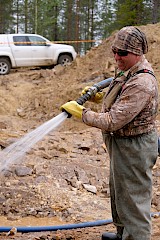 Aurion collected 39 surface rock chip or grab samples from angular boulders and bedrock that assayed from nil to 705.0 g/t Au from the YNOT area in 2017, so in 2018 the company followed-up on this discovery.
Aurion collected 39 surface rock chip or grab samples from angular boulders and bedrock that assayed from nil to 705.0 g/t Au from the YNOT area in 2017, so in 2018 the company followed-up on this discovery.
Trenching unearthed an east-west gold-bearing quartz shear vein and associated extensional quartz stockwork veins hosted by moderate to strong iron-carbonate, silica and hematite altered clastic sediments. YNOT quartz veins are variably mineralized with pyrite, chalcopyrite, iron oxides and locally VG. The system is up to 10 m wide and has a strike length of 260 m (open). The zone is exposed in 5 of 6 trenches at the YNOT prospect, which is located 3.6 km NW of Aamurusko. The YNOT zone is a drill-ready exploration target.
Notable gold assays from YNOT channel samples are:
- 7.18 g/t Au over 1.52 m including 31.50 g/t Au over 0.34 m (Trench WNT1801)
- 17.55 g/t Au over 0.60 m (Trench WNT1801)
- 0.47 g/t Au over 6.05 m (altered wall rock at Trench WNT1801)
- 2.86 g/t Au over 0.27 m (Trench WNT1802)
- 2.56 g/t Au over 0.43 m (Trench WNT1802)
Gold-bearing grab samples of angular boulders near YNOT trenches assayed 23.9 g/t Au (180 m southwest) and 23.5 g/t Au (750 m east) and provide local gold targets for exploration in future. Aurion is exploring the 3.6 km gap between YNOT and Aamurusko with ground geophysical surveys, mapping and prospecting.
A2
A2 is a prospecting discovery where 52 rock samples of quartz veins, quartz stockworks, breccias and tension vein arrays, occur in outcrop, sub-crop and angular boulders along a 1.1 km long arcuate structure. Selective grab samples returned assays from nil to 697.0 g/t Au (average 59.6 g/t Au).
Eleven drill holes tested a strike length of 450 m targeting gold mineralization in quartz veins hosted by altered clastic sediments at the A2 prospect, located 1.2 km north-northwest of Aamurusko.
The most significant drill intercept at A2 was 22.00 g/t Au over 0.45 m from 38.45 m (Drill hole AM18041). Current drilling has not yet explained prospecting discoveries at A2.
Risti NW
Located approximately 4 to 5 km north-northwest of Aamurusko, limited prospecting has identified gold-bearing quartz blocks over a distance greater than 1.8 km. At Risti NW 133 rock samples from angular boulders and sub-crop assayed an average of 1.94 g/t Au including 11 that assayed greater than 5 g/t Au to a high of 108.5 g/t Au. Risti NW is a grassroots gold prospect that warrants further exploration.
Kaaresselkä (originally found by GTK)
The 315 ha Kaaresselkä project is adjacent to the Sirkka shear zone and located 4 km south-southwest of Aamurusko. The prospect consists of multiple shear hosted gold zones up to 16 m wide and 650 m long.
GTK discovered Kaaresselkä and conducted extensive geochemical and geophysical surveying, trenching and diamond drilling on the target. Tertiary Minerals plc. (“Tertiary”) later acquired the project by staking in 2003 and subsequently completed geochemical and geophysical surveys with limited drilling in 2004.
Notable high-grade drill intercepts include:
- 11.0 g/t Au over 4.9 m from 74.80 m (Drill hole 04KD007B)
- 13.5 g/t Au over 2.75 m from 15.45 m (Drill hole 04KD005)
All mineralized zones remain open along strike and down dip.
Aurion purchased 100% of Kaaresselkä from Tertiary in 2016. The Kaaresselkä property is subject to certain pre-production royalties and a 2% NSR (net smelter returns) royalty on production. Aurion has the option to buy back 50% of the NSR royalty for a cash payment of US$1 million at any time prior to commencement of commercial production. Since 2016, Aurion has compiled historical work but has not yet commenced exploration at Kaaresselkä.

